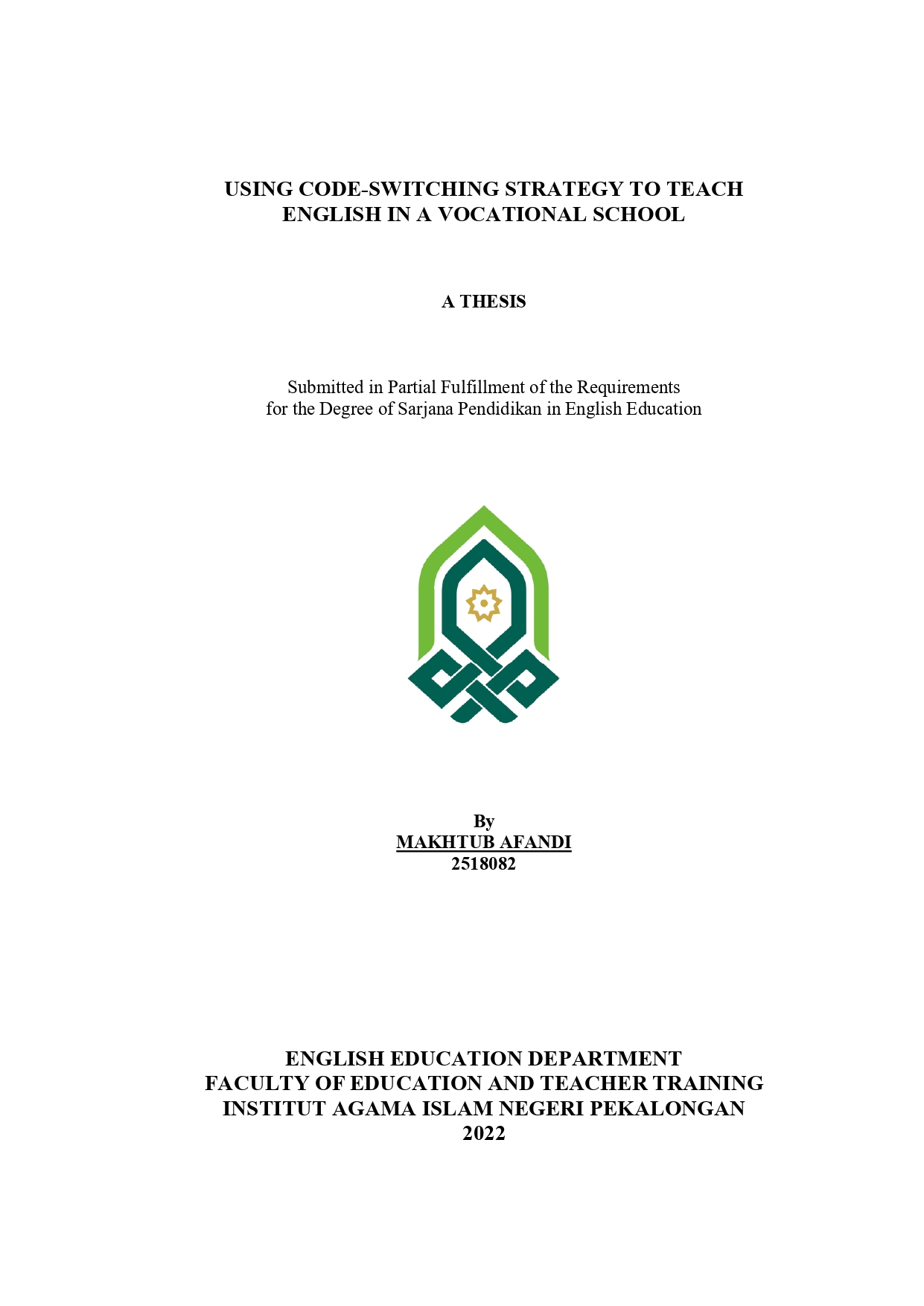
SKRIPSI TADRIS BAHASA INGGRIS
Using Code-Switching Strategy to Teach English in A Vocational School
English is a global language and vital in many fields, including technology, science,
entertainment, business, and education. In addition, English is used in Indonesian
education. Teaching English has been implemented in high schools, especially in
vocational schools. Code switching strategy is the use of two or more languages in
teaching. It is often used by vocational school teachers during teaching English.
This study aims to know more about the use of code switching for teaching English
in a vocational school. The research design in this study used descriptive research.
The researcher uses interviews and observation to collect data. Data analysis
techniques using thematic analysis with the aim of finding patterns, themes, sub
themes within a data set Miles, Huberman, & Saldana. The contribution of this
research is to provide an overview of using code switching strategy for teaching
English in a vocational school. The findings reported that vocational school teacher
use code switching to teach English, vocational school teacher implement code
switching to explain the material learning, to explain double meaning words, to
give an assessment or instruction, to build a teacher-student communication, and
to control the classroom. While the challenges faced by vocational school teacher
are students do not understand new words, the teacher must translate or match the
words into the original language, the teacher needs repetition to convey the
material, the teacher should learn more about new material, students consider
English is a difficult language, students less intense in learning English.
Keywords: code switching, vocational school, teaching English.
REFERENCES
Ariffin, K., & Rafik-Galea, S. (2009). Code-switching as a communication device
in conversation. Language & Society, 5.
Arikunto, Suharsimi. (2010). Prosedur Penelitian Suatu Pendekatan Praktik.
Jakarta: Rineka Cipta
Butzkamm, W. (2003). We only learn language once. The role of the mother tongue
in FL classrooms: death of a dogma. The Language Learning Journal, 28(1),
29-39. doi: 10.1080/09571730385200181
Creese, A., & Blackledge, A. (2010). Translanguaging in the bilingual classroom:
A pedagogy for learning and teaching? The Modern Language Journal,
94(1), 103-115.
Ellis, R., & Shintani, N. (2013). Exploring Language Pedagogy through Second
Language Acquisition. Research Retrieved from
http://otago.eblib.com.au/patron/FullRecord.aspx?p=1331869
Esfandiari, R. (2015). An Investigation into ESAP Needs of Iranian BA Students
of Law. The Journal of Teaching Language Skills (JTLS), 7(3), 29–59.
Ferguson, G. (2003). Classroom code-switching in post-colonial contexts:
Functions, attitudes and policies. AILA review, 16(1), 38-51.
Garrett, P. (2010). Attitudes to Language. Cambridge University Press
Gass, S. M., & Selinker, L. (2008). Second Language Acquisition (third ed.).
London: Routledge.
Godstime, T, & Joseph, Amaechi. (2016). The Relevance of Technical and
Vocational Skills Acquisition Programme in the Development and
Empowerment of Rural Youths in Niger Delta Region, Nigeria. Journal of
Scientific and Engineering Research, 3(6): 473-478
Gulzar, M. A. (2010). Code-switching: Awareness about its utility in bilingual
classrooms. Bulletin of Education and Research, 32(2), 23-44.
Harzing A-W, Feely AJ. (2008). The language barrier and its implications for HQsubsidiary
relationships. Cross-Cultural Management: An International
Journal 15(1): 49-61.
H. Douglasd Brown. (2000). Principle of Language Learning and Teaching. New
York: Addison Wesley Longman, Inc.
Macaro, E. (2005). Code Switching in the L2 classroom: a communication and
learning strategy. In E. Llurda (Ed.), Non-native language teachers:
perceptions, challenges, and contributions to the professions (pp. 63-84).
United States of America: Springer.
Macaro, E. (2009). Teacher use of codeswitching in the second language classroom:
Exploring ‘optimal’ use. In M. Turnbull and J. Dailey-O’Cain (Eds.) First
Language Use in Second and Foreign Language Learning. Bristol:
Multilingual Matters. 35–49.
Miles, Matthew B., Huberman, A. M., & Saldana, J. (2014). Qualitative data
Analysis “a methods sourcebook.” United States of America: SAGE
Publications.
Mulyasa. (2007). Standar Kompetensi dan Sertifikasi Guru. Bandung: Remaja
Rosdakarya.
Shartiely, N. E. (2013). Discourse strategies of lecturers in higher education
classroom interaction: a case at the University Dar Es Salaam, Tanzania
(Doctoral dissertation, Stellenbosch: Stellenbosch University).
Then, D. C.-O., & Ting, S.-H. (2011). Code-switching in English and science
classrooms: more than translation. International Journal of Multilingualism,
8(4), 299-323. doi: 10.1080/14790718.2011.577777
Unamuno, V. (2008). Multilingual switch in peer classroom interaction. Linguistics
and Education, 19(1), 1-19. doi: 10.1016/j.linged.2008.01.002
Üstunel, E. (2016). EFL classroom code-switching. Turkey: Palgrave Macmillan.
Widodo, H.P. (2014). Contextually framing the design of ESP Materials:
Vocational English Reading Tasks. In H. Emery & N. Moore (Eds).
Ketersediaan
| 23SK2325051.00 | SK TI 23.051 MAK u | My Library (Lantai 3. Local Content) | Tersedia |
Informasi Detail
- Judul Seri
-
-
- No. Panggil
-
SK TI 23.051 MAK u
- Penerbit
- Pekalongan : Jurusan S-1 Tadris Bahasa Inggris FTIK UIN K.H. Abdurrahman Wahid Pekalongan., 2022
- Deskripsi Fisik
-
xv, 39 hlm., 30 cm; Bibliografi: 40-41
- Bahasa
-
Inggris
- ISBN/ISSN
-
-
- Klasifikasi
-
371. 36
- Tipe Isi
-
-
- Tipe Media
-
-
- Tipe Pembawa
-
-
- Edisi
-
-
- Subjek
- Info Detail Spesifik
-
-
- Pernyataan Tanggungjawab
-
Makhtub Afandi (2518082)
Versi lain/terkait
Tidak tersedia versi lain
Lampiran Berkas
Komentar
Anda harus login sebelum memberikan komentar
 Karya Umum
Karya Umum  Filsafat
Filsafat  Agama
Agama  Ilmu-ilmu Sosial
Ilmu-ilmu Sosial  Bahasa
Bahasa  Ilmu-ilmu Murni
Ilmu-ilmu Murni  Ilmu-ilmu Terapan
Ilmu-ilmu Terapan  Kesenian, Hiburan, dan Olahraga
Kesenian, Hiburan, dan Olahraga  Kesusastraan
Kesusastraan  Geografi dan Sejarah
Geografi dan Sejarah